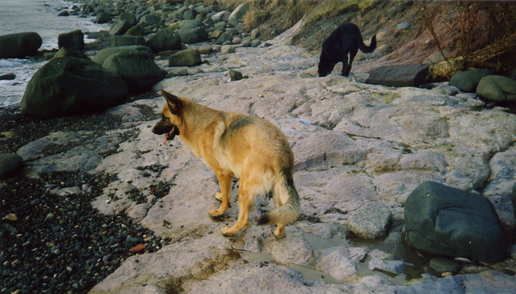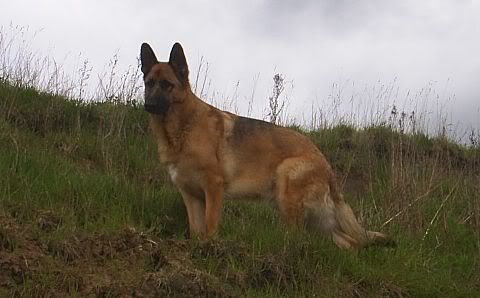
This is a placeholder text
Group text
by eichenluft on 05 October 2007 - 03:10
That's what I said too! "Golden" - black/tan without the saddle - not a sable.
molly
by greatestgsd on 05 October 2007 - 04:10

shep/mal
by Louise M. Penery on 05 October 2007 - 04:10
Here is a Karly Arminius grand-daughter (Hexe von der Kapellenhöhe) whose black saddle has almost completely faded:

by Ceph on 05 October 2007 - 04:10
I can go tomorrow to the library to look up an article written in Genetica that describes the coat color inheritance of the Belgians...that would probably let you know what restricts the black on the body but still allows for the melanistic mask to come through. Its probably also the same gene that causes pug and anatolian shepherd color...but it is def. Sable - you can see the different colors on the hairs even in the picture.
If I am correct though that fawn color is caused by the "Gold/Tan Sable" allele which restricts the black pigment on the body...I dont know if it is dominant or recessive to the grey sable...I want to say it is dominant but I vaguely remember something about it changing in the last couple of years. I think Willis mentioned this allele too.
Here is another Belgian site that might explain it : http://www.belgiandogs.org/gengilesbsd.htm
The dog probably isnt Black and Tan though - the black on the muzzle is definetley the Extension Locus. The only genes that I know of that effect the black fur are the white masking gene which is recessive at the extension locus, the Blue allele (which would turn the mask and the nose blue) and the Liver allele (which would turn the mask and the nose brown). The Intensity Locus also effects fading, but only on Tan markings.
~Cate
by fda on 05 October 2007 - 08:10
Following from what Alderstein said.. This was s a lad of ours ..
He was a typical black and tan pup except his very immature puppy coat appeared a little chalky but by the time he was3 months he was typical black and tan pup .He was germanic/continental show lines..
as a pup ...



by thhe time he was 18 months/ 2..


by pod on 05 October 2007 - 10:10
marci
What you mean is that... there are dark Sable pups that fade in Black as they mature ( making them Grey...and not Solid Black..) and there are light greys...( very little Black-shading that grows deeper in Black overlay.) making the dog dark SABLE or almost Bi-color when the pup grows..???
Basically there are two types of sable- alleles Ay and aw
Ay has a very wide range in expression and there are two factors which influence this. Shade, which can vary from pale cream to deep red.... and shading, which can range from very light to heavily shaded. Any of these can occur with or without mask. From photos and links posted here it seems the GSDs does have this type of sable with a wide range of expression (if these are to be taken as pedigree).
Good example of wide range in expression can be seen in the Teuveren as they have shade ranging from fawn to deep red and various levels of shading. These are all Ay sables.
All sable pups are born heavily shaded, sometimes almost black. I don't know if it's possible to tell at birth which will retain heavy shading and which won't, but they all fade to some extent.
aw - wolf sable is different in that it doesn't fade, or at least not nearly so much. They can be very similar at birth especially in breeds that have mask which obscures the facial pattern. If the mask wasn't present you would see the typical pattern.... like the Littlest Hobo had. This isn't present in Ay sables.
The presence of mask can also influence shading which is why some Shepherd do actually darken in colour ie shading increases and these are usually the one with heavy mask, but don't know if these could be confused with bicolours.
Briefly, the "e" allelle leads to gradual fading of the black pigment in the coat toward a tan color but does not affect the nose, eyes, pads etc. As a recessive, it only operates in ee combination.Many people mistake the faded "ee" dog for a golden sable but "ee" animals have a red, as opposed to a black, tip to the tail. "ee" dogs can be born black and tan and the black will gradually fade over time. The fading may not be complete until the dog is two years of age.
Willis was actually incorrect on this. The e allele (in double dose ee) restricts all black pigment. There is no fading. Puppies are born white, cream or red and remain more or less the same colour. There should be no mistaking a faded saddle or golden sable for an ee dog as there is no black pigment at all, not even a mask in ees.... except I should mention, the odd occurrence of individual black hairs or sometimes spots which are somatic mutations.
The dog in marci's photo is very similar to a faded saddle, but it would be very, very unusual to get this in one so young, and you would expect to see some remains of black pigment in the saddle area.
by Reggae on 05 October 2007 - 11:10
It is also unlike the dog in Reggae's post. The latter dog is a black and tan with very faded pigment in general. Note the pale, almost white markings inside of the legs.
Louise - Our dog was homozygous sable, not black/tan. She was bred by the kennel I worked for before we bought her to a black/tan male for 10 sable pups. Bred to two solid black males for 9 sables and 7 sables. Last litter was to a bicolor, again 10 sable pups. None of her pups had her markings, all had much more black, but the males she was bred with where selected for darker pigment.by ladywolf45169 on 05 October 2007 - 11:10

not a really good pic of my Hazy girl, but unfortunately, i don't have any other good ones on my laptop. I know where she came from, and KNOW that she was a full GSD. Your little one looks alot like her as well.
However, I recently had 2 dogs stolen from me by Rosehaven Kennels in Ohio that look like this too. And I have proof that they were GSD/Mal cross!!! Unfortunatley, I didn't know that when I purchased them.
My best advice to you, if you are unsure and do not trust where the animal come from, get it fixed and simply love it!
by pod on 05 October 2007 - 12:10
It is also unlike the dog in Reggae's post. The latter dog is a black and tan with very faded pigment in general. Note the pale, almost white markings inside of the legs.
The pale areas aren't really a defining feature of faded saddles as this it's normal for most colours, infact most mammals, to have paler pigment on ventral surfaces. It's just an evolutionary adaptation designed to save energy.... why produce pigment where it's not particularly needed.
by Laris on 05 October 2007 - 12:10
Contact information Disclaimer Privacy Statement Copyright Information Terms of Service Cookie policy ↑ Back to top




